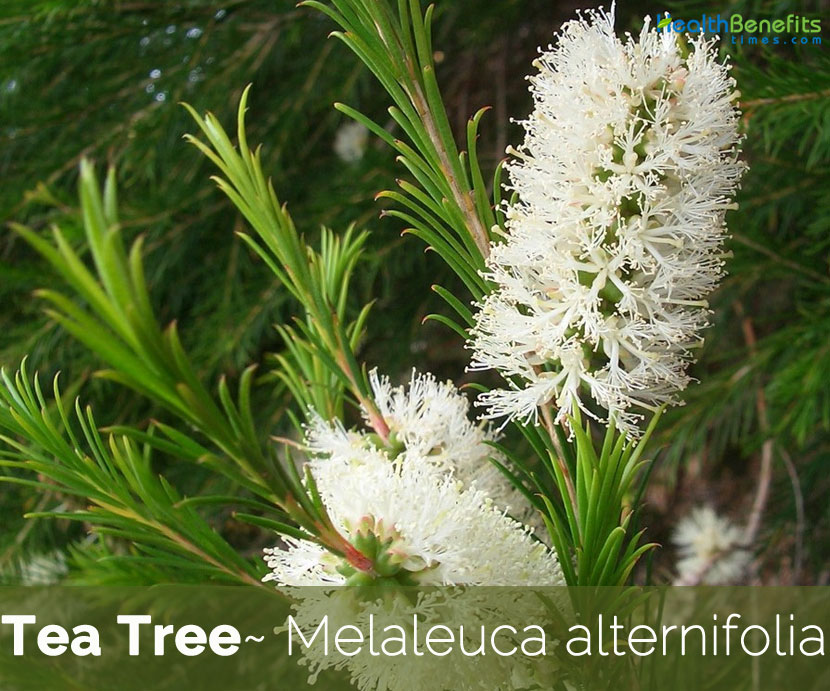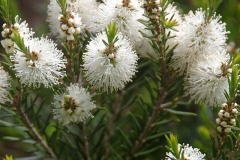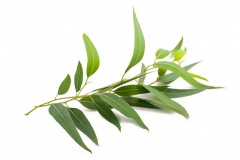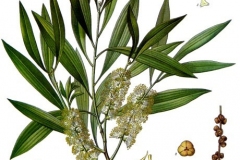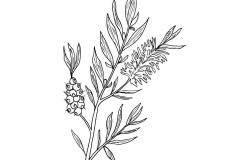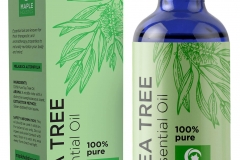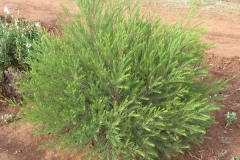Melaleuca is a combination of two Greek words: melas meaning black and leukos meaning white, in reference to the contrasting black trunk and young white stems or branches that are characteristic of many species in this genus. Alternifolia is derived from Latin and means having alternate leaves (ie. leaves on one side of a stem join the stem at nodes that are between the leaf nodes on the other side). These plants produce fragrant oils that both speed skin healing and kill off any bugs trying to cause skin infections. Tea tree is an excellent alternative to antibiotic cream and one that should be used to replace those nasty creams. Tea tree is grown from cuttings in summer. The leaves and small branches are picked throughout the year and distilled to produce essential oil.
Tea Tree Facts
| Tea Tree Quick Facts | |
|---|---|
| Name: | Tea Tree |
| Scientific Name: | Melaleuca alternifolia |
| Origin | Australia, it occurs in southeast Queensland and the north coast |
| Shapes | Short, cylindric or squarish, woody capsules 2–3 mm (0.08–0.1 in) in diameter |
| Health benefits | Heals Infections, Skin problems, Oral Health, Wound Healing, Cure Acne, Skin Infections, Cold Sores (Herpes), Head Lice, Dandruff |
| Name | Tea Tree |
|---|---|
| Scientific Name | Melaleuca alternifolia |
| Native | Endemic to Australia, it occurs in southeast Queensland and the north coast and adjacent ranges of New South Wales |
| Common Names | Narrow-leaved Paperbark, Narrow-leaved Tea-tree, Narrow-leaved Ti-tree, Snow-in-summer, Teatree, Australian Tea tree |
| Name in Other Languages | Arabic: Biliqa’ mutabadalat al’awraq (بلقاء متبادلة الأوراق) Catalan: Arbre del te Czech: Kajeput střídavolistý English: Narrow-leaf paperbark, Narrow-leaf teatree, Teatree, Australian Tea tree Swedish: Teoljebuske Finnish: Paperikaarnamyrtti French: Arbre à thé Galician: Árbore do té German: Australischer Teebaum, Teebaum Hungarian: Ausztrál teafa Japanese: Tītsurī (ティーツリー) Malay: Gelam wangi Occitan: Arbre de tè Polish: Melaleuka skrętolistna Slovenian: Čajevec Spanish: Arbol de té Swedish: Teoljebuske |
| Plant Growth Habit | Small tree or evergreen shrub |
| Growing Climates | Swamps by the coast, along streams, on swampy flats, in dense, impenetrable and thickets |
| Soil | Thrives best in- a fertile, well-drained moisture retentive lime-free soil in full sun. Prefers seasonally wet areas, standing water or well-drained uplands, can tolerate freezes once established |
| Plant Size | About 7 m (20 ft.) |
| Bark | Whitish, Spongy, peeling, papery bark |
| Leaf | Smooth, soft, linear in shape, 10–35 mm (0.4–1 in) long and 1 mm (0.04 in) wide. They are also rich in oil with the glands prominent |
| Flowering season | June |
| Flower | White or cream-colored masses of spikes 3–5 cm (1–2 in) long over a short period, mostly spring to early summer, and give the tree an appearance of looking fluffy. |
| Fruit Shape & Size | Short, cylindric or squarish, woody capsules 2–3 mm (0.08–0.1 in) in diameter with many tiny seeds |
| Plant Parts Used | Leaves and twigs |
| Available Forms | Cream, Essential oil, Infusion |
| Health Benefits |
|
Plant Description
Tea Tree is an evergreen shrub or small narrow-leaved, hardwood tree that grows about 7 m (20 ft.) tall with a bushy crown. The plant is found growing in swamps by the coast, along streams, on swampy flats, in dense, impenetrable and thickets. The plant thrives best in- a fertile, well-drained moisture retentive lime-free soil in full sun. Prefers seasonally wet areas, standing water or well-drained uplands, can tolerate freezes once established. It does not grow well on shallow light sandy soils, heavy clay soils and acid sulfate soils. The plant has whitish, spongy, peeling, papery bark. The entire plant is glabrous.
Leaves
Leaves are arranged alternately, sometimes scattered or whorled. The leaves are smooth, soft, linear in shape, 10–35 mm (0.4–1 in) long and 1 mm (0.04 in) wide. The petiole is 1 mm long. They are also rich in oil with the glands prominent. Leaves smell of camphor when crushed.
Flowers
The inflorescences are many-flowered spikes, 3-5 cm long over a short period, mostly spring to early summer, with axes bearing short hairs. The white flowers are solitary and petals are 2-3 mm long. The flowers are scattered in an interrupted spike. The stamens are 30-60 in number and more than 12 mm long, united at their bases to form 5 distinct bundles. Flowering normally takes place during June.
Fruits
Fertile flowers are followed by the capsule that continues within the fruiting hypanthium. The fruits are spaced sparsely along the branches. The fruit is small, cylindric or squarish, woody capsules 2–3 mm (0.08–0.1 in) in diameter with many tiny seeds are scattered along the branches. A hole of 1.5-2.5 mm diameter is present which enables the release and dispersal of seeds by wind.
Tea tree, and in particular its essential oil, is one of the most important natural antiseptics. It is useful for stings, burns, wounds, and skin infections of all kinds; the herb merits a place in every medicine chest.
History
Maleleuca alternifolia is native to the eastern half of Australia, known as New South Wales and Queensland. Captain James Cook documented its first use in the 18th century, where he used the leaves to brew an accented tea. Thus, the name “Tea Tree” was created, but the Aboriginal people of Australia had alternative uses for the plant. Native inhabitants used the elasticity and softness of the bark to create sleeping mats and cradles. Additionally, they would use the bark to seal canoe holes, preserve food, and block rainfall. Perhaps the most critical use, which is still appropriate in today’s society, is the use of its oil. The Aboriginal people used the oil on the leaves to cure various skin and health disorders.
Health benefit of Tea tree
Listed below are some of the popular health benefits of Tea tree
1. Heals Infections
Tea tree essential oil was first investigated in 1923 in Australia. Since the 1960s it has been intensively investigated, and its antiseptic properties are well established. Clinical trials, mainly in Australia, have shown that it is effective at treating a broad range of infectious conditions, particularly fungal and skin problems such as vaginal yeast infections, acne, and warts. It may also be taken internally to treat infections, particularly cystitis, mononucleosis, and post viral fatigue syndrome. It is an excellent remedy for a range of vaginal yeast infections.
2. Skin problems
Active ingredients like terpene hydrocarbons, monoterpenes and sesquiterpenes are found abundantly in tea tree and these compounds give Tea Tree its antibacterial, antiviral and antifungal activity. Tea tree oil or cream can be applied to skin infections such as athlete’s foot and ringworm, as well as to corns, warts, acne and boils, infected burns, scrapes, wounds, insect bites and stings, and other skin conditions.(+)
3. Oral Health
The herb is effective in mouthwashes, countering oral infection and gum disease, and it can also be used as a gargle for sore throats. (+)
4. Wound Healing
Due to its anti-bacterial, anti-microbial and antiseptic compounds, Tea Tree essential oil is an effective wound healer that prevents infection. (+)
Research has concluded that 8 out of 11 wounds treated with Tea Tree reduced in size and began to heal. Another research found that the essential oil was effective at treating antibiotic resistant bacteria, in particular, Staphylococcus aureus.(+)
5. Cure Acne
The anti-microbial and anti-inflammatory properties of Tea Tree make it a widespread essential oil for the treatment of acne, calming redness, swelling and inflammation. Tea Tree may also reduce the appearance of acne scars.
In a research conducted in 2017, the participants applied Tea Tree oil to their faces daily for 12 weeks. At the end of the study the researchers concluded that the use of the Tea Tree oil products considerably improved mild to moderate acne. In another research it was determined to be just as effective at treating acne as benzoyl peroxide, with less chance of severe negative side effects.
6. Skin Infections
Tea tree oil is quite effective for treating fungal infections such as athlete’s foot, candida and toenail fungus. The antimicrobial and antiseptic properties of the oil help to disinfect the affected foot area and prevent spreading of the fungus to other body parts. It also acts as an astringent that decreases the redness, scaly, cracked skin or skin peeling on the infected area, therefore speeding up the healing process.
7. Cold Sores (Herpes)
Tea Tree is quite effective against the herpes simplex virus which causes cold sores. Research concluded that, Tea Tree oil and Eucalyptus oil are capable to exert a direct antiviral effect on HSV (herpes simplex virus). Though the active anti-herpes components of Australian tea tree and eucalyptus oil are not yet known, their possible application as antiviral agents in recurrent herpes infection is promising.” (+)
8. Head Lice
Tea Tree is a potent insecticidal that has proven an effective natural treatment for head lice. Parasitology Research has discovered that a treatment of Tea Tree oil resulted in 100 percent mortality after just 30 minutes of exposure. Additionally, a higher concentration of the essential oil induced a failure of 50 percent of the eggs to hatch. (+)
To make your own natural head lice treatment just add a few drops of Tea Tree oil to your favorite carrier oil, wrap in a towel, leave overnight and wash in the morning. Do this for a few consecutive nights to guarantee the lice and eggs are thoroughly eliminated. (+)
9. Dandruff
Study found that a 5 percent solution of Tea Tree oil was more effective than a placebo at treating dandruff. There was also a reported 41 percent improvement in symptoms. Participants also reported an improvement of itchiness and greasiness after using the Tea Tree shampoo.
Traditional uses and benefits of Tea Tree
- Tea tree, and its essential oil, is one of the most important natural antiseptics and it merits a place in every medicine chest.
- It is useful for treating stings, burns, wounds and skin infections of all kinds.
- An essential oil obtained from the leaves and twigs is strongly antiseptic, diaphoretic and expectorant.
- It encourages the immune system and is effective against a broad range of bacterial and fungal infections.
- It is used in the treatment of chronic and some acute infections, notably cystitis, glandular fever and chronic fatigue syndrome.
- It is used externally in the treatment of thrush, vaginal infections, acne, athlete’s foot, verrucae, warts, insect bites, cold sores and nits.
- It is applied neat to verrucae, warts and nits, but is diluted with carrier oil such as almond for other uses.
- Indigenous Australians of eastern inland areas use “tea trees” as a traditional medicine by inhaling the oils from the crushed leaves to treat coughs and colds.
- They also sprinkle leaves on wounds, after which a poultice is applied.
- Tea tree leaves are soaked to make an infusion to treat sore throats or skin ailments.
- It is also known to reduce inflammation and may be effective in the treatment of fungal infections such as Athlete’s foot.
- Oil has been proven to treat topical bacterial (acne), fungal (athletes foot), and viral infections in humans.
- It has been effective in curing respiratory problems such as bronchitis and asthma.
- When converted into mouthwash or toothpaste, it can kill canker sores, bad breath, and gum disease.
- Bundjalung Aborigines of New South Wales inhaled vapors from crushed tea tree leaves by applying a poultice made of tea tree leaves to treat coughs, colds, insect bites, abrasions, and skin infections.
- It is used as an antiseptic and disinfectant for wounds and heals burns.
- It is also effective for the treatment of dandruff and scalp problems.
- It can be used for treatment of bleeding gums, gingivitis and periodontal disease.
- It is useful for treating stings, burns, wounds and skin infections of all kinds.
- It stimulates the immune system and is effective against a broad range of bacterial and fungal infections.
- It is used in the treatment of chronic and some acute infections, notably cystitis, glandular fever and chronic fatigue syndrome.
- It is used externally in the treatment of thrush, vaginal infections, acne, athlete’s foot, verrucae, warts, insect bites, cold sores and nits.
- It is an active ingredient of many topical preparations for the treatment of cutaneous infections including wound infections, fungal dermatoses, otitis media, and acne.
Other Facts
- An essential oil obtained from the leaves is strongly germicidal and is also used in dentistry, deodorants, soaps, mouthwashes etc.
- Wood is very durable in wet conditions and in damp ground.
- For pets, the use of a topical solution can reduce and cure skin issues such as bug bites and ringworm.
- Abundant aroma from the tea tree oil is used in the perfume industry as soaps and fragrances with its earthy, pungent smell.
- Tea tree is truly versatile and provides society with a natural alternative for skincare products.
- Wood is durable underground and water and is valued for boats, cabinetry, carving, cross ties, fence rails, flooring, gunstocks, mine beams, pilings, posts, rafters, railway sleepers, ships and wharves.
Precautions
- Do not take internally.
- It may cause central nervous system depression along with ataxia and drowsiness.
- It may also cause stomatitis, vomiting, diarrhea and gastrointestinal irritation when taken orally.
- Tea tree oil should not be ingested in large amounts due to its toxicity and may cause skin irritation if used topically in high concentrations.
References:
https://pfaf.org/user/Plant.aspx?LatinName=Melaleuca+alternifolia
https://en.wikipedia.org/wiki/Melaleuca_alternifolia
https://npgsweb.ars-grin.gov/gringlobal/taxonomydetail.aspx?id=402629
https://apps.cals.arizona.edu/arboretum/taxon.aspx?id=824
http://tropical.theferns.info/viewtropical.php?id=Melaleuca+alternifolia


